317th Fighter-Interceptor Squadron
The 317th Fighter Interceptor Squadron is an inactive United States Air Force unit, last assigned to Aerospace Defense Command, being stationed at Elmendorf Air Force Base, Alaska, where it was inactivated on 31 December 1969.
317th Fighter Interceptor Squadron
 | |
|---|---|
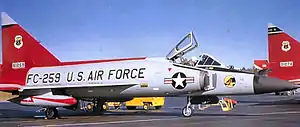 317th Fighter-Interceptor Squadron F-102 Delta Dagger[note 1] | |
| Active | 1942–1945; 1946–1969 |
| Country | |
| Branch | |
| Role | Interceptor |
| Part of | Aerospace Defense Command |
| Motto(s) | ' |
| Engagements |
|
| Decorations |
|
| Insignia | |
| Patch with the 317th Fighter-Interceptor Squadron emblem (approved 13 December 1951)[1] | 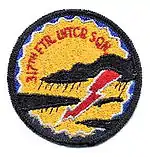 |
The squadron was first activated as the 317th Fighter Squadron. During World War II, it saw combat in the Mediterranean Theater of Operations, where it earned two Distinguished Unit Citations for its actions. After V-E Day, the squadron returned to the United States and was inactivated.
The squadron returned to service as an air defense unit in 1947, serving in that role until inactivated in 1969.
History
World War II
The 317th Fighter Squadron was activated on 1 July 1942 at Theodore Green Airport, Providence, Rhode Island, as part of the 325th Fighter Group, the "Checker Tails". After six months of intensive training in the Curtiss P-40 Warhawk, the 317th embarked for North Africa aboard the USS Ranger (CV-4), in consort with its sister squadrons, the 318th and 319th. The 317th flew its first combat mission in the Mediterranean Theater of Operations (MTO) under Twelfth Air Force on 17 April 1943. Flying P-40 Warhawks, Republic P-47 Thunderbolts and North American P-51 Mustangs, the 317th fought in 13 separate campaigns where it earned two Distinguished Unit Citations in action over Italy and Sardinia. In October 1945, after the conclusion of the European air war, the 317th returned to the United States and was inactivated.
Air Defense Command
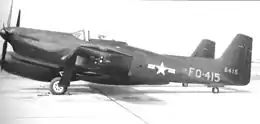
In May 1947, the squadron was reactivated at Mitchel Field, New York and equipped with Northrop P-61 Black Widows. it moved to Moses Lake Air Force Base, Washington, the squadron was re-equipped with the new North American F-82 Twin Mustang in October 1948. The squadron was assigned for the defense of the Hanford Nuclear Reservation in Eastern Washington. One month later it was reassigned to Hamilton Air Force Base, California, and in April 1950, returned to McChord Air Force Base, Washington.
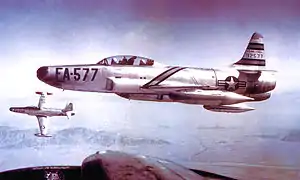
In 1951. the squadron was redesignated as the 317th Fighter Interceptor Squadron, a component of the 25th Air Division, Air Defense Command, During the period between 1947 and 1956. the 317th flew the F-82. the Lockheed F-94 Starfire, and the North American F-86D Sabre interceptor. In 1955 and 1956, at Vincent Air Force Base, Yuma, Arizona, flying the F-86D, the 317th engaged in airborne rocket competition, breaking all records previously set. In August 1956 the squadron was selected as the best air defense unit in the Air Force and was awarded the Hughes Trophy, In addition, the squadron received its first Outstanding Unit Award for high combat readiness for the period of 1953 through 1956. In November 1956, the 317th began transitioning into the Convair F-102 Delta Dagger.
Alaskan Air Command
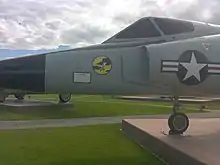
In November 1956, the 317th began transitioning into the F-102A Delta Dagger, becoming the second squadron to receive the new delta-winged supersonic aircraft. In August 1957, the 317th was reassigned in force, to Elmendorf Air Force Base, Alaska, where it assumed air defense mission of the southern portion of Alaska and the northwestern approaches to the United States.
In the summer of 1960. the 449th Fighter-Interceptor Squadron was inactivated and Ladd Air Force Base was closed. leaving the entire Alaska air defense mission to the 317th. To carry out this mission, the squadron was authorized 40 aircraft and 60 pilots. The squadron received its second Air Force Outstanding Unit Award for maintaining full combat readiness during and after the 1964 Alaska earthquake on 27 March 1964.
In the summer of 1965, the 317th was reduced to 29 aircraft and the manning reduced accordingly, but the air defense mission remained the same. In October 1965, the squadron was awarded the Hughes Trophy for the second time, and a third Air Force Outstanding Unit Award for combat readiness.
In December 1969, due to budget reductions, the 317th Fighter-Interceptor Squadron was inactivated.
Lineage
- Constituted as the 317th Fighter Squadron on 24 June 1942
- Activated on 3 August 1942.
- Inactivated on 28 October 1945
- Activated on 25 August 1947
- Redesignated 317th Fighter Squadron (All Weather)' on 10 May 1948
- Redesignated 317th Fighter-All Weather Squadron on 20 January 1950
- Redesignated 317th Fighter-Interceptor Squadron on 1 May 1951[2]
- Inactivated on 31 December 1969[3]
Assignments
|
|
Stations
|
|
Aircraft
|
|
See also
| Wikimedia Commons has media related to 317th Fighter-All Weather Squadron. |
References
- Notes
- Aircraft is Convair F-102A-70-CO Delta Dagger serial 56-1259
- Aircraft is North American P-82F Twin Mustang serial 46-415 at Hamilton AFB, California in 1948.
- Aircraft is Lockheed F-94A-5-LO serial 49-2577, taken in 1951. The 317th FIS was the first squadron with the F-94A Starfire.
- Citations
- Maurer, Combat Squadrons, pp. 386–387
- Lineage, including assignments and stations, through 1963 in Maurer, Combat Squadrons, pp. 386–387
- Cornett & Johnson, p. 124
Bibliography
![]() This article incorporates public domain material from the Air Force Historical Research Agency website http://www.afhra.af.mil/.
This article incorporates public domain material from the Air Force Historical Research Agency website http://www.afhra.af.mil/.
- Cornett, Lloyd H; Johnson, Mildred W (1980). A Handbook of Aerospace Defense Organization, 1946–1980 (PDF). Peterson AFB, CO: Office of History, Aerospace Defense Center. Retrieved 23 March 2012.
- Maurer, Maurer, ed. (1983) [1961]. Air Force Combat Units of World War II (PDF) (reprint ed.). Washington, DC: Office of Air Force History. ISBN 0-912799-02-1. LCCN 61060979. Retrieved 17 December 2016.
- Maurer, Maurer, ed. (1982) [1969]. Combat Squadrons of the Air Force, World War II (PDF) (reprint ed.). Washington, DC: Office of Air Force History. ISBN 0-405-12194-6. LCCN 70605402. OCLC 72556. Retrieved 17 December 2016.
- Pape, Garry R.; Campbell, John M.; Campbell, Donna (1991). Northrop P-61 Black Widow: The Complete History and Combat Record. Minneapolis, MN: Motorbooks International. ISBN 978-0-879385-09-5.
- "ADCOM's Fighter Interceptor Squadrons". The Interceptor. Aerospace Defense Command. 21 (1): 5–11, 26–31, 40–45, 54–59. January 1979.
